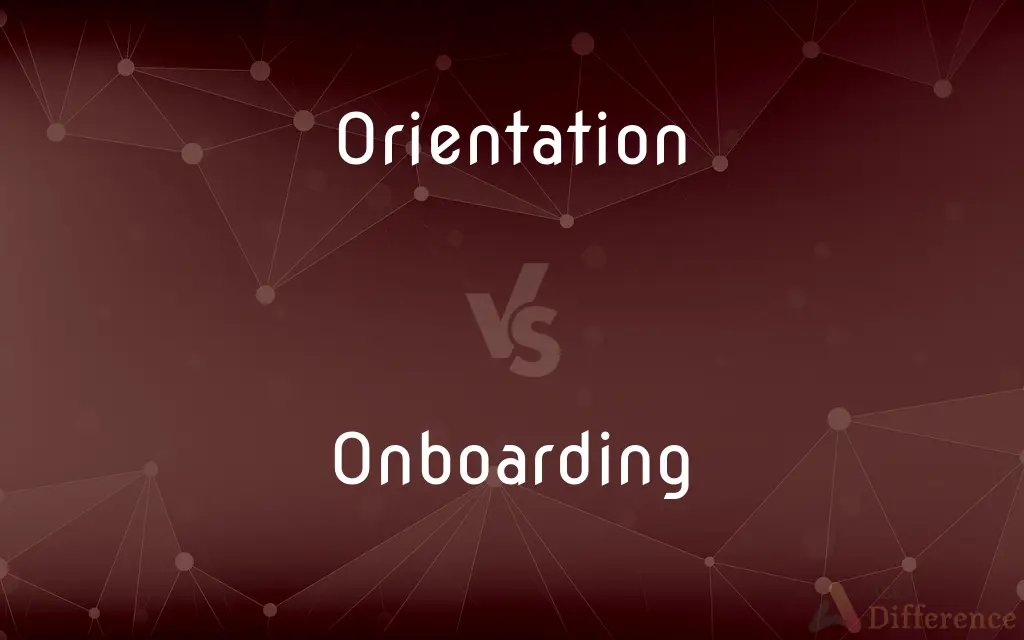Orientation vs. Onboarding — What's the Difference?
By Tayyaba Rehman & Maham Liaqat — Updated on April 17, 2024
Orientation introduces new employees to their immediate workspace and colleagues, focusing on initial procedures, while onboarding is a comprehensive process integrating new hires into the company culture and their roles over a period.

Difference Between Orientation and Onboarding
Table of Contents
ADVERTISEMENT
Key Differences
Orientation is typically a short-term event lasting a few hours to a couple of days, aimed at introducing new employees to their immediate working environment and basic company policies. Whereas, onboarding is a more extensive process that can last from a few weeks to several months, designed to fully integrate new hires into the company and their specific roles.
During orientation, new employees receive crucial information about workplace rules, safety protocols, and administrative procedures. On the other hand, onboarding includes these aspects but also encompasses training in job-specific tasks, setting performance expectations, and longer-term career development planning.
Orientation is often seen as a preliminary step that precedes the deeper, more strategic process of onboarding. While orientation is about compliance and acquaintanceship, onboarding aims at building engagement and a deeper understanding of the company's strategic goals.
The focus of orientation is primarily logistical, helping new hires to navigate their new workspaces, understand their schedules, and know where resources are located. Conversely, onboarding focuses on building relationships between the new hire, their colleagues, and management, which are crucial for collaborative work environments.
Orientation can sometimes be generic and not tailored to specific job roles within the company. On the other hand, onboarding is usually customized to meet the needs of the new employee's specific role, involving more personalized training and mentorship.
ADVERTISEMENT
Comparison Chart
Duration
Short-term (hours to days)
Long-term (weeks to months)
Focus
Immediate workspace, basic policies
Comprehensive integration, company culture
Goals
Inform about logistical details
Ensure deep integration and role proficiency
Customization
Often generic
Highly personalized
Relationship Building
Minimal focus
High focus on building internal relationships
Compare with Definitions
Orientation
A preliminary introduction for new hires to learn about company policies and their immediate environment.
During her orientation, she learned where the emergency exits and restrooms were located.
Onboarding
Includes detailed job training and performance expectations.
Onboarding helped her understand her sales targets and the tools she'd use daily.
Orientation
Typically lasts only a few hours to a few days.
His orientation lasted two days during which he completed all necessary HR paperwork.
Onboarding
Can extend over several months.
His onboarding continued with regular check-ins and training sessions for three months.
Orientation
Focuses on logistical details and initial company rules.
The orientation session covered parking arrangements and network login credentials.
Onboarding
Tailored to the individual’s role within the company.
As a manager, his onboarding included leadership training.
Orientation
Often conducted in a group setting.
They attended a group orientation that included a tour of the office.
Onboarding
A comprehensive process to integrate new hires into the company culture and their roles.
Her onboarding process included meetings with key team members and project training.
Orientation
Provides basic, essential information to all new hires.
Orientation ensured she knew the basics of daily operations in her new company.
Onboarding
Aims to build strong internal relationships and engagement.
Onboarding introduced him to his mentors and colleagues in the department.
Orientation
The action of orienting someone or something relative to the points of a compass or other specified positions
Studies of locational awareness and orientation in young children
Onboarding
Onboarding, also known as organizational socialization, is management jargon first created in the 1970s that refers to the mechanism through which new employees acquire the necessary knowledge, skills, and behaviors in order to become effective organizational members and insiders. In the United States, for example, up to 25% of workers are organizational newcomers engaged in an onboarding process.Tactics used in this process include formal meetings, lectures, videos, printed materials, or computer-based orientations that outline the operations and culture of the organization that the employee is entering into.
Orientation
A person's basic attitude, beliefs, or feelings in relation to a particular subject or issue
His book is well worth reading, regardless of your political orientation
Onboarding
(business) The process of bringing a new employee on board, incorporating training and orientation.
Orientation
Familiarization with something
Many judges give instructions to assist jury orientation
Orientation
The act of orienting or the state of being oriented.
Orientation
Location or position relative to the points of the compass.
Orientation
The construction of a church so that its longitudinal axis has an east-west direction with the main altar usually at the eastern end.
Orientation
The direction followed in the course of a trend, movement, or development.
Orientation
A tendency of thought; a general inclination
A Marxist orientation.
Orientation
An adjustment or adaptation to a new environment, situation, custom, or set of ideas.
Orientation
Introductory instruction concerning a new situation
Orientation for incoming students.
Orientation
(Psychology) Awareness of the objective world in relation to one's self.
Orientation
(countable) The determination of the relative position of something or someone.
Orientation
(countable) The relative physical position or direction of something.
Orientation
(uncountable) The construction of a Christian church to have its aisle in an east-west direction with the altar at the east end.
Orientation
(countable) An inclination, tendency or direction.
Orientation
(countable) The ability to orient, or the process of so doing.
The homing instinct in pigeons is an example of orientation.
Orientation
(countable) An adjustment to a new environment.
Orientation
(countable) An introduction to a (new) environment.
Orientation
(education) Events to orient new students at a school; events to help new students become familiar with a school.
Orientation
The direction of print across the page; landscape or portrait.
Orientation
The choice of which ordered bases are "positively" oriented and which are "negatively" oriented on a real vector space.
Orientation
The designation of a parametrised curve as "positively" or "negatively" oriented (or "nonorientable"); the analogous description of a surface or hypersurface.
Orientation
The act or process of orientating; determination of the points of the compass, or the east point, in taking bearings.
Orientation
The tendency of a revolving body, when suspended in a certain way, to bring the axis of rotation into parallelism with the earth's axis.
Orientation
An aspect or fronting to the east; especially (Arch.), the placing of a church so that the chancel, containing the altar toward which the congregation fronts in worship, will be on the east end.
Orientation
A return to first principles; an orderly arrangement.
The task of orientation undertaken in this chapter.
Orientation
The act of orienting
Orientation
An integrated set of attitudes and beliefs
Orientation
Position or alignment relative to points of the compass or other specific directions
Orientation
A person's awareness of self with regard to position and time and place and personal relationships
Orientation
A course introducing a new situation or environment
Common Curiosities
Why is onboarding considered important?
Onboarding is crucial for helping new hires understand their roles deeply, align with company culture, and build necessary relationships within the company.
What is the main difference between orientation and onboarding?
Orientation is a brief introduction to the company, focusing on logistical details, whereas onboarding is a comprehensive, longer-term process aimed at fully integrating an employee into the company.
Is orientation mandatory for all new employees?
Typically, yes, orientation is mandatory as it covers essential workplace safety and policy information.
Can a company have either orientation or onboarding, not both?
Yes, some companies might conduct only orientation or onboarding, but most find a combination of both to be most effective.
What elements are typically included in the onboarding process?
Onboarding may include detailed job training, mentorship, performance reviews, and cultural immersion sessions.
Can the length of onboarding vary between roles within the same company?
Yes, onboarding length can vary significantly depending on the complexity and level of the role.
Is there a best practice for how onboarding should be done?
Best practices suggest tailoring the onboarding process to individual roles, involving multiple departments, and ensuring it aligns with long-term strategic goals.
How long does each process typically last?
Orientation usually lasts from a few hours to a few days, while onboarding can last from a few weeks to several months.
Who is responsible for conducting orientation and onboarding?
HR typically handles orientation, while onboarding might involve HR, direct supervisors, and sometimes even higher management.
How do orientation and onboarding affect an employee's performance?
Effective orientation and onboarding significantly enhance job performance and satisfaction by providing clear expectations and necessary resources.
What happens if an employee skips orientation or onboarding?
Skipping these processes can lead to confusion about job duties, lower engagement, and potential non-compliance with company policies.
What are common challenges in onboarding employees?
Challenges can include aligning personal goals with company objectives, logistical issues in training, and integrating remote workers.
What tools are used during onboarding?
Tools can include training manuals, performance management software, and internal communication platforms.
How do international companies handle orientation and onboarding?
International companies often have localized versions of orientation and a standardized global onboarding process to maintain consistency.
What are the benefits of doing orientation properly?
Proper orientation helps ensure compliance with company policies, aids in quick adjustment of new hires, and reduces initial workplace anxiety.
Share Your Discovery

Previous Comparison
Nag vs. Snag
Next Comparison
Aristocracy vs. RoyaltyAuthor Spotlight
Written by
Tayyaba RehmanTayyaba Rehman is a distinguished writer, currently serving as a primary contributor to askdifference.com. As a researcher in semantics and etymology, Tayyaba's passion for the complexity of languages and their distinctions has found a perfect home on the platform. Tayyaba delves into the intricacies of language, distinguishing between commonly confused words and phrases, thereby providing clarity for readers worldwide.
Co-written by
Maham Liaqat















































